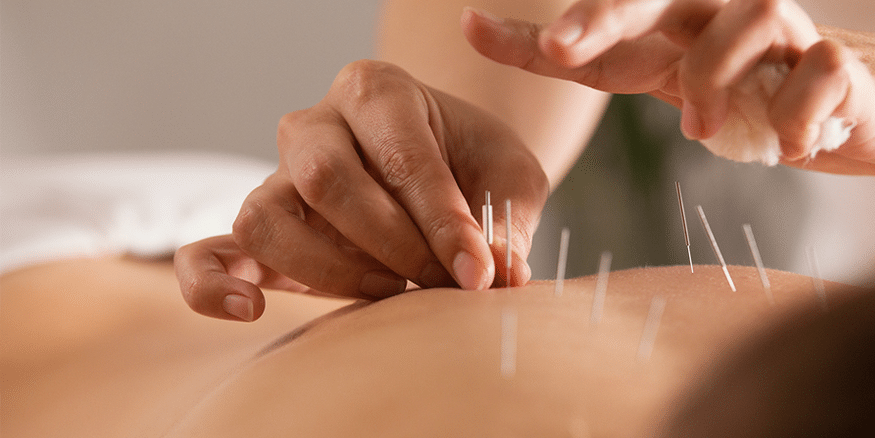
Acupuncture and Digestion
Before the thought of needles makes you run away in fear, or simply skip this article, think about this: an acupuncture needle is only about the diameter of a thick hair, so acupuncture is not painful. My favourite way to describe acupuncture is to de-emphasize the ‘puncture’ part of the word and emphasize the ‘aaaahhhh’ part. Try saying it like a sigh: aaahhhhcupuncture.
Many countries, including Canada and the US, once banned the ancient practice of acupuncture, a major treatment component of Traditional Chinese Medicine (TCM). Now many conventional Western health practitioners accept acupuncture as a legitimate treatment option for some conditions.
A Treatment Session
Curious about what happens during acupuncture treatment for a gastrointestinal (GI) disorder? Keep in mind that TCM treats the whole body and acupuncture is only part of a complete disease management plan. This means that there is no specific treatment plan for every ailment but rather the practitioner designs an individualized plan for each patient. Remember as well, that you should not quit any medication that you are taking unless you notify your physician and confirm it with your acupuncturist or doctor of TCM.
Even when a problem manifests in the abdominal area, your treatment plan could include acupuncture points elsewhere on the body, such as the arms or legs. For example, a female patient may come in with symptoms of bloating and gas. After assessing her using TCM diagnostic criteria, the practitioner could select acupuncture points on her left hand between her thumb and index finger and sites below her knees. Another patient may have the same symptoms, but his treatment could call for acupuncture points on his back and the back of his legs. Treatment could also vary from session to session for the same patient.
During the procedure, while you’re comfortably lying down, the practitioner inserts sterile single use tiny needles into your skin at selected points, aiming to achieve a ‘needling sensation’ called de qi. This sensation includes feelings of heaviness, aching, tingling, numbness, electricity, and warmth. It is quite soothing and patients often fall asleep during treatment, which could include leaving the needles in place for 20-45 minutes, with the acupuncturist manually stimulating the points every 10-15 minutes.
After treatment, patients may feel tired, or a bit groggy, as if they have just woken up from a nap. It’s a good idea not to plan anything over-stimulating, such as vigorous exercise after treatment, and to drink plenty of room temperature or warmer water as this often helps to re-energize following treatment.
Sessions could range from a daily occurrence to as few as once per month, or even once per season, but usually a management plan includes treatment once or twice per week.
Adverse Reactions to Acupuncture
In general, acupuncture is accepted as a safe practice; however, as with any form of treatment, there are some cautions.
Two prospective surveys of practitioners, reviewed in the British Medical Journal, involving 32,0001 and 34,0002 individual acupuncture treatments respectively, reported only infrequent minor adverse events such as slight bleeding and mild pain for this treatment modality. In the first study, adverse event rates were classified using the British Medical Association medical ethics standards.
The most common side effects from acupuncture treatment are bruising, minor bleeding, or pain occurring in less than 2% of cases. More rarely, fainting can occur, particularly for nervous, new patients, or for those with a history of fainting. To lessen the risk, make sure that you have eaten something within a couple of hours before your treatment. You should also be lying down during acupuncture. Be sure to let your practitioner know if you have a history of fainting, and of any blood thinners you may be taking
In a small percentage of patients, symptoms could worsen before improving. This is generally a sign that healing has begun. Be sure to contact your practitioner if worsening of symptoms is severe or lasts more than two days.
To avoid complications, it is important to tell your practitioner about any health condition you have prior to treatment, and to ensure he or she uses only sterile, disposable needles. Having offered these caveats, acupuncture is a very safe and effective treatment modality.
Qualified Practitioners
Quebec, Alberta, and British Columbia all regulate acupuncture under the Health Professions Act, the same act that regulates nurses, doctors, and physiotherapists, so when choosing a TCM practitioner, verify that he or she is registered and licensed. In other provinces, check with friends, family, and your current healthcare providers for people whom they trust.
So, the next time you think of acupuncture, say aaahhhcupunture, and then think relief of your digestive issues.
